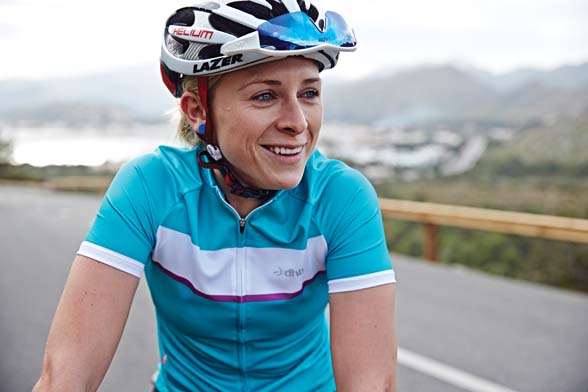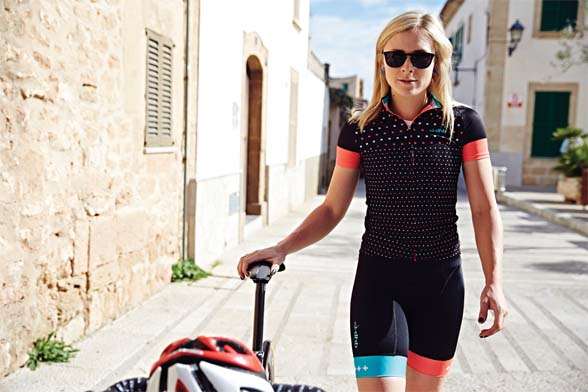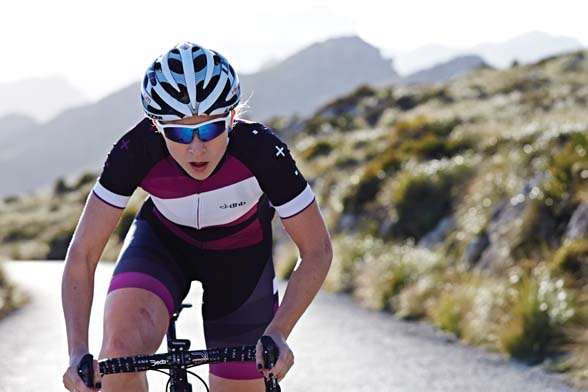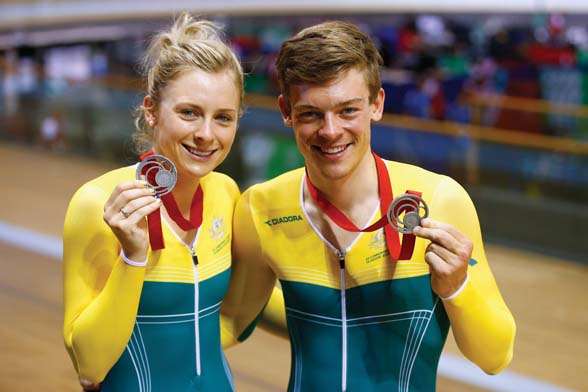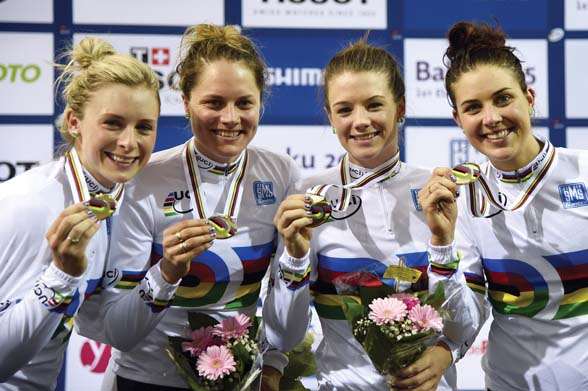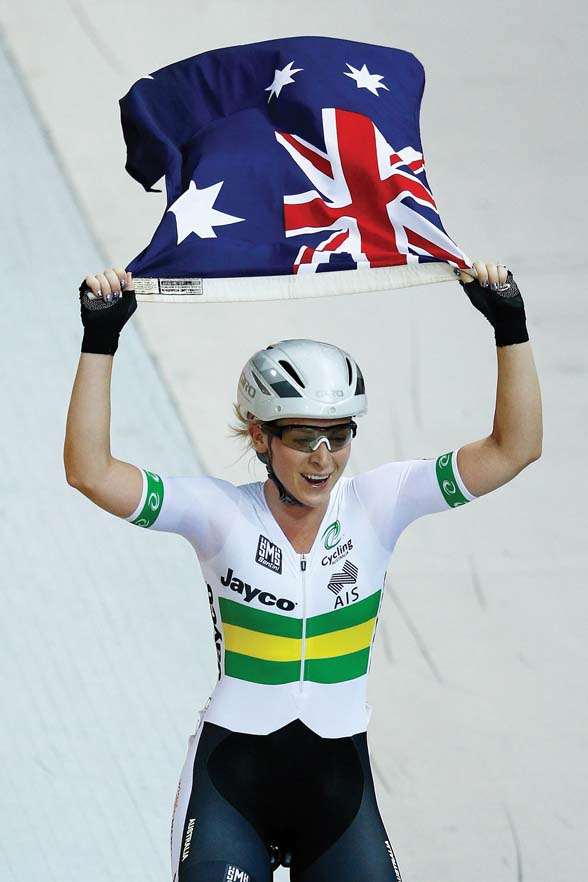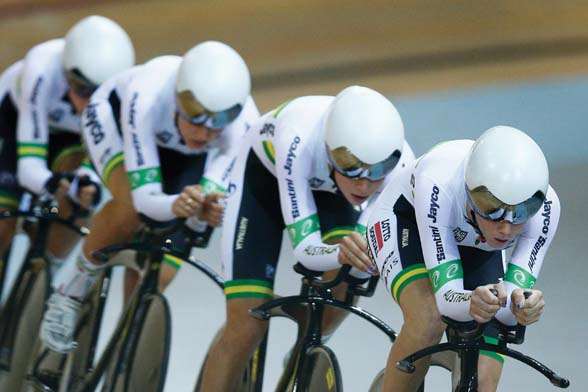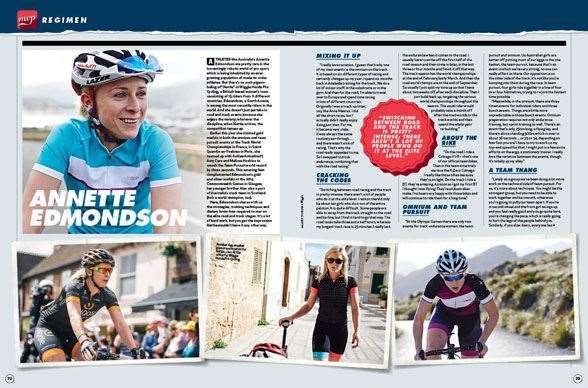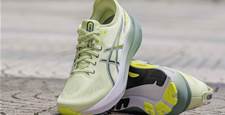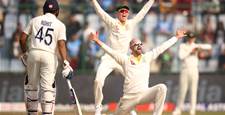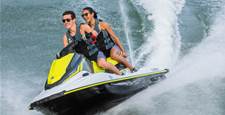Mastering one discipline is hard enough, but Nettie loves the variety.
Athletes like Australia’s Annette Edmondson are pretty rare in the increasingly robotic world of pro sport, which is being inhabited by an ever-growing population of made-to-order athletes. But there’s no such pigeon-holing of “Nettie” at Wiggle Honda Pro Cycling, a British-based women’s team consisting of 15 riders from 11 different countries. Edmondson, a South Aussie, is among the most versatile riders in the world. And she doesn’t just partake in road and track events because she enjoys the variety; whatever the discipline, when Nettie arrives, the competition tenses up.
Earlier this year she claimed gold medals in both the omnium and team pursuit events at the Track World Championships in France; in Saint-Quentin-en-Yvelines in Paris, she teamed up with Ashlee Ankudinoff, Amy Cure and Melissa Hoskins to smash the Team Pursuit world record by three seconds. This amazing feat complemented Edmondson’s gold and silver medals at the 2014 Commonwealth Games in Glasgow, her younger brother Alex also a part of Australia’s crack team in Scotland (he’s a world champion, too).
Here, Edmondson shares with us the strategies, training techniques and dietary know-how required to star on the elite road and track stages. It’s a lot of hard work, but you get the impression Nettie wouldn’t have it any other way.
MIXING IT UP
“I really love variation. I guess that’s why one of my main events is the omnium on the track. It is based on six different types of racing and certainly changes up my year. I spend six months back in Adelaide training for the track. We do a lot of indoor stuff, in the velodrome or in the gym. And then for the road, I’m able to travel over to Europe and spend time racing in lots of different countries. Originally I was a track sprinter, say, like Anna Meares. I did all the short races, but I actually didn’t really enjoy doing just that. For me, it became very stale; it was always the same routine year-through ... and there wasn’t a lot of racing. That’s why the road really appealed to me. So I swapped to track endurance, combining that with the road racing.”
CRACKING THE CODES
“Switching between road racing and the track is pretty intense; there aren’t a lot of people who do it at the elite level. I reckon there’d only be about ten girls who do it out of the entire peloton. It is quite difficult. Some people are able to swap from the track straight to the road and be fine, but I find it hard to go that way. The road races take three and a half hours, whereas my longest track race is 25 minutes. I really lack the endurance when it comes to the road. I usually have to write-off the first half of the road season and then come in later, in the last three or four months and finish it off that way. The track season has the world championships at the end of February/early March. And then the road world champs are at the end of September. So usually I just split my time up so that I have about two weeks off after each discipline. Then I just build back up, targeting the various world championships throughout the season. The usual rider would probably take a month off after the road worlds or the track worlds and then spend the whole year re-building.”
ABOUT THE BIKE
“On the road I ride a Colnago V1-R – that’s one of our official team bikes. Then in the team time trials we race the K-Zero Colnago. I really like those bikes because they’re so light. On the track I ride a BT; they’re amazing. As soon as I got my first BT I thought I was flying! They’re an Australian make. I’ve been very happy with those bikes and will continue to ride them for a long time.”
OMNIUM AND TEAM PURSUIT
“At the Olympic Games there are only two events for track endurance women; the team pursuit and omnium. Us Australian girls are better off putting most of our eggs in the one basket, the team pursuit, because that’s an event in which we’re very strong; no one can really affect us there. Our opposition is on the other side of the track; it’s not like you’re bumping into them during the race. In team pursuit, four girls ride together in a line of four over four kilometres, trying to record the fastest time possible. Meanwhile, in the omnium, there are three timed events for individual riders and three bunch events. Things are a little more unpredictable in those bunch events. Omnium preparation requires not only endurance training, but sprint training as well. There’s an event that’s only 250m long, a flying lap, and there’s also a standing 500m, which is over in about 36 seconds ... or 35 or 34, depending on how fast you are! I have to try to work on my top-end speed for that. I might put in a few extra efforts on the ergo, a stationary trainer. I really love the variation between the events, though. It’s totally up my alley.”
A TEAM THANG
“Lately as a group we’ve been doing a lot more work on the technical side of team pursuit. For us, it’s more about technique. You might be the strongest group, but you need to be able to work together and be smooth, otherwise you’re going to pull your team apart. If you’re in second wheel and the front girl swings up, and you feel really good and you go quite hard, you’re changing the pace, which is really going to hurt the legs of the people behind you. Similarly, if you slow down, everyone has to put the brakes on behind you, which means someone else is going to have to pick the pace back up.”
IN THE SWING
“As for the swing in track cycling, everyone’s approach is individual. For example, I do a different swing to my team-mate Mel Hoskins. I don’t go as high; hers is a lot higher and looks a lot more impressive. She’s so used to coming down quite quickly and getting back on. It’s all about being as smooth as possible and using the least amount of energy as possible; the aim is to sit very close to the wheel and time your swing up, over and around the group perfectly so that you land back down on the wheel in front of you without using too much excess effort. Sometimes as a rider you change-up your swing style, but this can be pretty difficult if you’ve maintained a certain technique for such a long time. Whatever you can do to preserve as much energy as possible is fine.”
TRAINING TRACK
“Usually you spend about two and a half hours at the track for each session. The first 20 minutes of that is usually a warm-up on the track itself. We’ll all head out together. Each rider will have a two-lap turn at the front of the group. They’ll then swing off to the back and so on. This might go on for 40-50 laps; between ten and 12.5km. Every time you swing off, you give the next girl a number ... sometimes you say the wrong number and get told off, so it’s good to keep everyone focussed. Then you come off, change your gears and hop back out there for some individual efforts. It might be four efforts, each about five minutes long. Or if you’re doing a sprint session, it might be four or so efforts over one lap each chasing a motorbike, which is travelling really fast. This might be an entire session on its own, where you’re working on your sprint fibres. Then we’ll have a ten-minute warm-down and that’s about it. Your warm-down depends on how tired you are. Sometimes it might be just some easy laps with the group, but most of the time I just go out on my road bike on the flat and go at my own pace in small gears, just spinning for ten minutes. In track training, it’s not like you’re riding the entire time, unless you’re doing a bunch race session, where you might spend half an hour behind a motorbike, have a rest, then do it again!”
SIBLING RIVALRY
“My brother Alex and I were very competitive kids growing up; we were always involved in similar sports – soccer, running, athletics. Then I got into cycling and then sure enough, so did he. He was always a mountain-biker, or a down-hiller, but all of a sudden he decided he was going to give road and track cycling a go, too. Growing up, if he’s achieved something, I’ve wanted to achieve it and vice-versa. He managed to become a world champion before I did ... which was very frustrating [laughs]. I was very excited for him, but it did give me extra motivation to try to do the same the following year. His first world title came the year after he just missed out on making the Olympic Games; he actually went to the Olympics, but he was number-five – only four of the guys got to ride. For him to be able to turn that disappointment around and become world champion was so impressive. As his sister, personally that’s probably one of my more proud moments.”
FOOD FOR THOUGHT
“Sometimes we get given the Vitamin Cs, the B1s, zincs and those sorts of things. Those are quite good just for making sure your immune system is up. Another good one is an iron supplement; sometimes if you’re working really hard, more so than your body is supposed to, iron can prove quite a key element. I know some people who can strictly focus on their diet all year-round, but I can’t. I find it really hard to keep to just all the good stuff. Coming into a major competition, that’s when I do tighten up and try not to eat too much chocolate, for example. If you can’t focus on being strict all year-round, you have to figure out when it’s okay to slacken off and when to tighten up. On race day, for me, bananas are great. Nutella sandwiches are another of my go-to foods. We have quite a few race days, and I know that works for me. When I’m doing the omnium, where there’s three different events on one day, and you race another three the next day, you need to make sure you are eating enough. Half the time it’s what works for you personally, what you enjoy and what’s going to stay down in your belly. I’m always loading my backpack full of Nutella sandwiches and bananas.”
MORNING GLORY
“For a three-hour morning training ride, I’ll make sure I have a good breakfast before heading out. And I’ll take maybe two or three muesli bars with me. I’ll eat one after an hour and then one every hour after that. If it’s not a muesli bar, I’ll have maybe half a sandwich or a banana. If you’re on the bike and you’re training and feeling hungry, then it’s usually too late. It’s incredible how fast your metabolism works when you’ve been doing intense exercise for many days on end. In a training block I might do, say, four hard days and then plan an easier one. On the other hand, six days’ racing in a row is quite punishing; you find yourself eating so much more than you did on the first couple of days. Your metabolism just goes crazy.”
OUT OF A SUITCASE
“I’m based in Adelaide for five-to-six months of the year. Then I head to Europe for another six. Two years ago I had seven months’ solid in Spain, then last year I only had two months on the road before going back to the track for two months in the middle of the year to prepare for the Comm Games. After that I went back to the road for two months; I was based in Italy with the AIS at their European training centre. This year, however, I was only on the road for two-three months all up. I’ve been living like a gypsy over the past few years, to be honest! If I was based anywhere for any longer than I have been, I reckon I would find a base to leave all my stuff, but because I’ve been racing so much, I’ve just been floating around. It’s been really fun.”
Related Articles
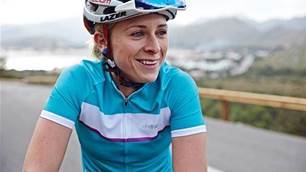
How cyclist Annette Edmondson trains for the track ... and the road
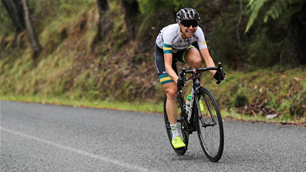
Tour of Guangxi

